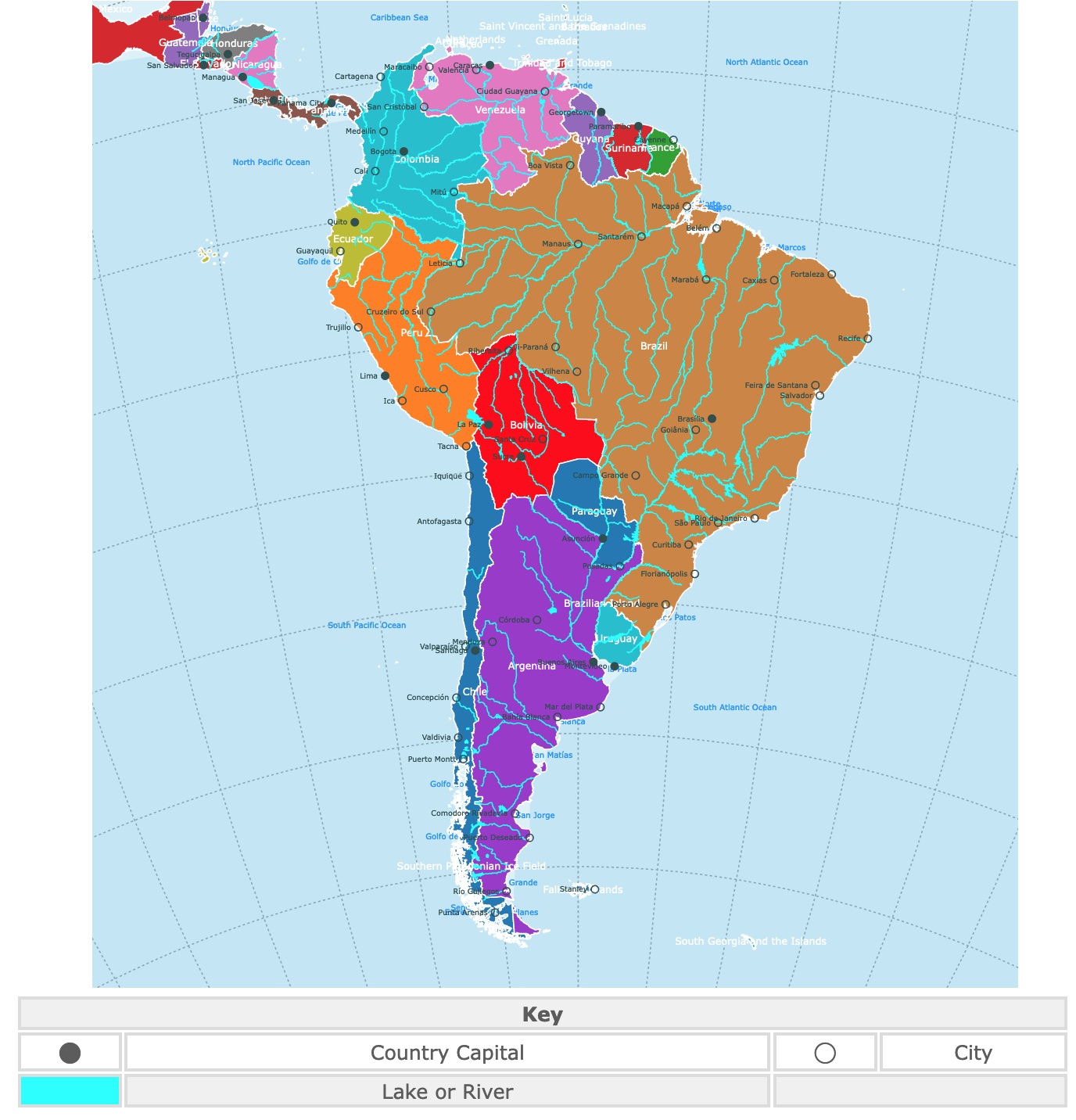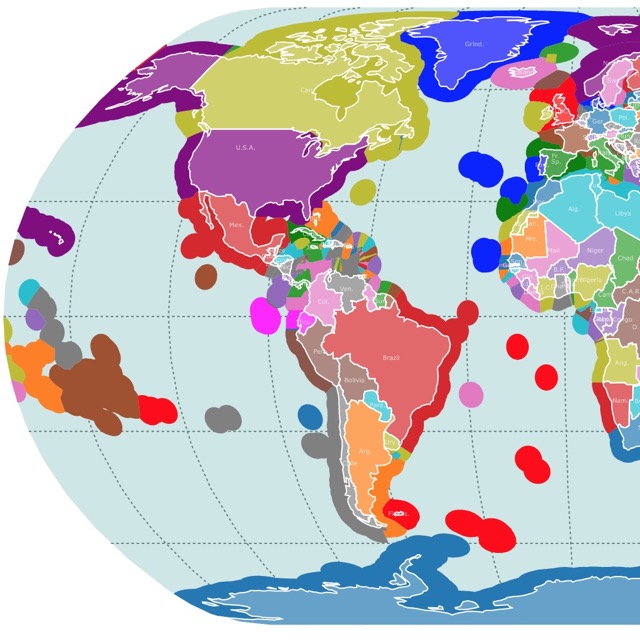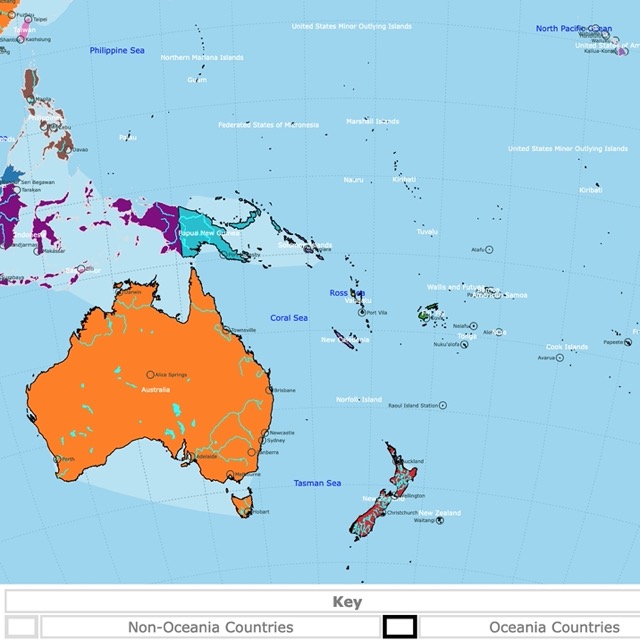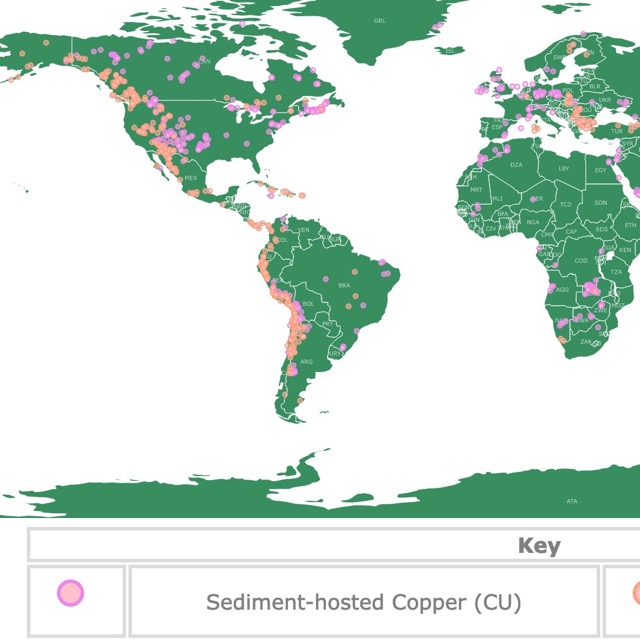Map of South America
This is an interactive political map of South America. It displays countries, rivers, lakes, and cities. Hover over the map for population, GDP, geography, and river names. To take a closer look, zoom in. For more information, scroll down.
| Key | ||||
|---|---|---|---|---|
| ⬤ | Country Capital | ◯ | City | |
| Lake or River | Ocean | |||
| Comunidad Andina | Mercosur | |||
SOUTH AMERICA
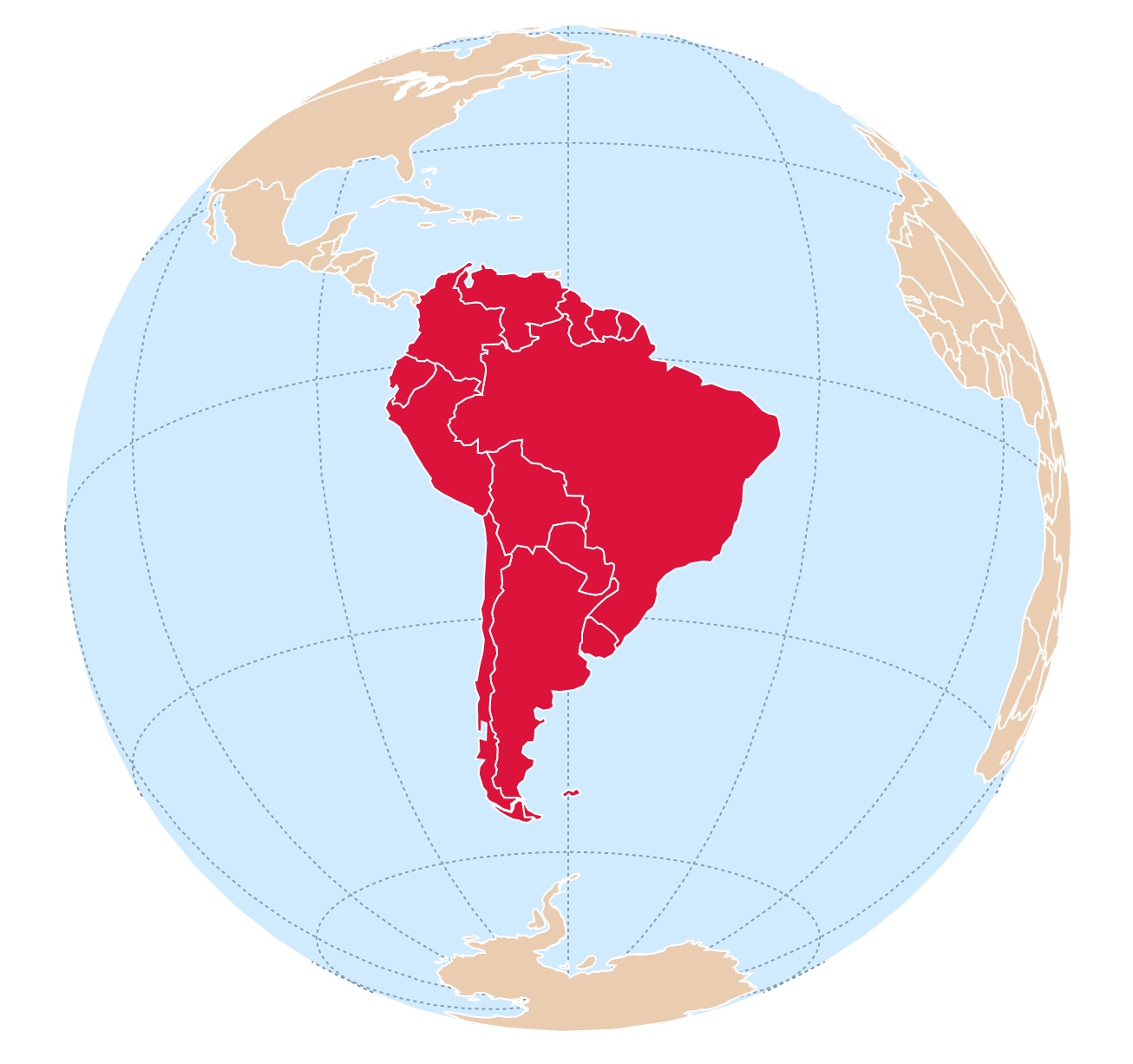
South America is a continent located primarily in the Western Hemisphere and the Southern Hemisphere.
It is situated east of the Pacific Ocean, west of the Atlantic Ocean, south of North America, and north of Antarctica.
The continent borders the Caribbean Sea to the northwest, and several countries form its northern and northeastern boundaries.
The southern portion of South America is marked by the convergence of the Atlantic and Pacific Oceans.
For a thorough review of South America's Geography, Amazon has The Geography of South America: A Scholarly Guide and Bibliography. Beginning with an overview of the region as a whole, successive chapters, one per nation, are divided by specific subdisciplines of geography: cultural, social, economic, historical, physical and environmental, political, and urban.
How Many Countries are in South America?
There are 16 countries in South America. These include territories of France and the United Kingdom.
What are the Safest Countries in South America?
The safest countries in South America for tourists and expats are Uruguay, Argentina, and Chile.
These countries often have lower crime rates and more stable political environments compared to other parts of South America.
Below are the Homicide Rates per 100,000 people (Statista, 2024).
Uruguy's rates have increased recently, but it is still perceived as a safe country. This is because robbery and kidnapping are not common as in other South American countries with lower homicide rates.
| Trade Bloc | Country | Capital | Homicide Rates |
|---|---|---|---|
| Comunidad Andina | Peru | Lima | 6 |
| Colombia | Bogotá | 25.4 | |
| Ecuador | Quito | 38.8 | |
| Bolivia | La Paz, Sucre | 3 | |
| Mercosur | Argentina | Buenos Aires | 3.8 |
| Brazil | Brasilia | 21.1 | |
| Paraguay | Asunción | 6.2 | |
| Uruguay | Montevideo | 10.6 | |
| Suspended from Mercosur | Venezuela | Caracas | 26.2 |
| EU | French Guiana (France) | Cayenne | 14.1 |
| Guyana | Georgetown | 16.2 | |
| Chile | Santiago | 5.5 | |
| Falkland Islands (United Kingdom) | Stanley | ||
| South Georgia and the South Sandwich Islands (United Kingdom) | King Edward Point | ||
| Suriname | Paramaribo | 40.1 |
South America's Geography
There are several geographic features and biomes that make South America diverse and unique.
Andes Mountains
The Andes is one of the world's longest mountain ranges and runs along the western coast of South America for about 7,000 kilometers (4,300 miles). Source: Guinessworldrecors.com.
It stretches across several countries, including Venezuela, Colombia, Ecuador, Peru, Bolivia, Chile, and Argentina.
Modern cities like La Paz, Quito, Arequipa, Cuenca, Medellin, Bogota, and Santiago are in the Andes Mountains.
The Andes are home to peaks over 6,000 meters (19,685 feet), including Aconcagua, the highest mountain outside of Asia.
The Andes Mountains were created over 50 million years ago when the South American and Pacific tectonic plates collided. Most of the peaks in the Andes are volcanic.
On the Andes mountains is the highest navigable lake on the planet, Lake Titicaca.

Amazon Rainforest
The Amazon Rainforest is the largest tropical rainforest in the world, covering a significant portion of northern South America.
It spans across Brazil, Peru, Colombia, Venezuela, Ecuador, Bolivia, Guyana, Suriname, and French Guiana.
The Amazon basin is known for its remarkable biodiversity, hosting countless species of plants, animals, and indigenous communities.
Patagonia
Patagonia covers parts of Argentina and Chile in the southern part of South America.
It is a sparsely populated region known for its dramatic landscapes, including vast steppes, deserts, mountains, glaciers, and fjords.
The southern tip of Patagonia is home to Tierra del Fuego, an archipelago shared by Argentina and Chile.
Atacama Desert
Situated in northern Chile, the Atacama Desert is the driest place on Earth. It averages about 2 millimeters (0.08 inches) of rainfall per year.
It stretches along the Pacific coast and is known for its extreme aridity.
The desert is characterized by vast salt flats, sand dunes, and unique rock formations.
Orinoco River Basin
The Orinoco River Basin covers a large part of Venezuela and parts of Colombia.
It is the third-largest river basin in South America, after the Amazon and Paraná.
The region consists of tropical rainforests, savannas, and wetlands, and it is home to diverse wildlife.
The Orinoco River flow has one of the most dramatic flow changes worldwide. As I remember, it can increase by 32 feet (10m) between the dry and wet seas
I studied the Orinoco River for my undergrad degree. Here is a link to my thesis!
Gran Chaco
The Gran Chaco is a vast lowland region located in Argentina, Paraguay, Bolivia, and Brazil. It is a sparsely populated area characterized by dry forests, savannas, and marshes.
The region is known for its extreme temperatures and diverse wildlife, including jaguars, tapirs, and capybaras.
If you plan to visit these geographic wonders, Expedia can help. Type the destination, and Expedia will give you the best fares and options.
History of South America
The continent has been home to indigenous peoples, some of whom built high civilizations before the arrival of Europeans in the late 1400s and early 1500s.
Indigenous peoples' lives were disrupted by European colonization from Spain and Portugal and by demographic collapse.
The result turned this continent into a melting pot of Spanish descendants, indigenous people, and mestizos.
Through the trans-Atlantic slave trade, South America (especially Brazil) became the home of millions of people of the African diaspora that, in turn, mixed with the locals.
The tensions between Europeans, indigenous peoples, and enslaved Africans and their descendants resulted in independence wars. By the 19th century, most of the continent had achieved its independence through hard-fought wars.
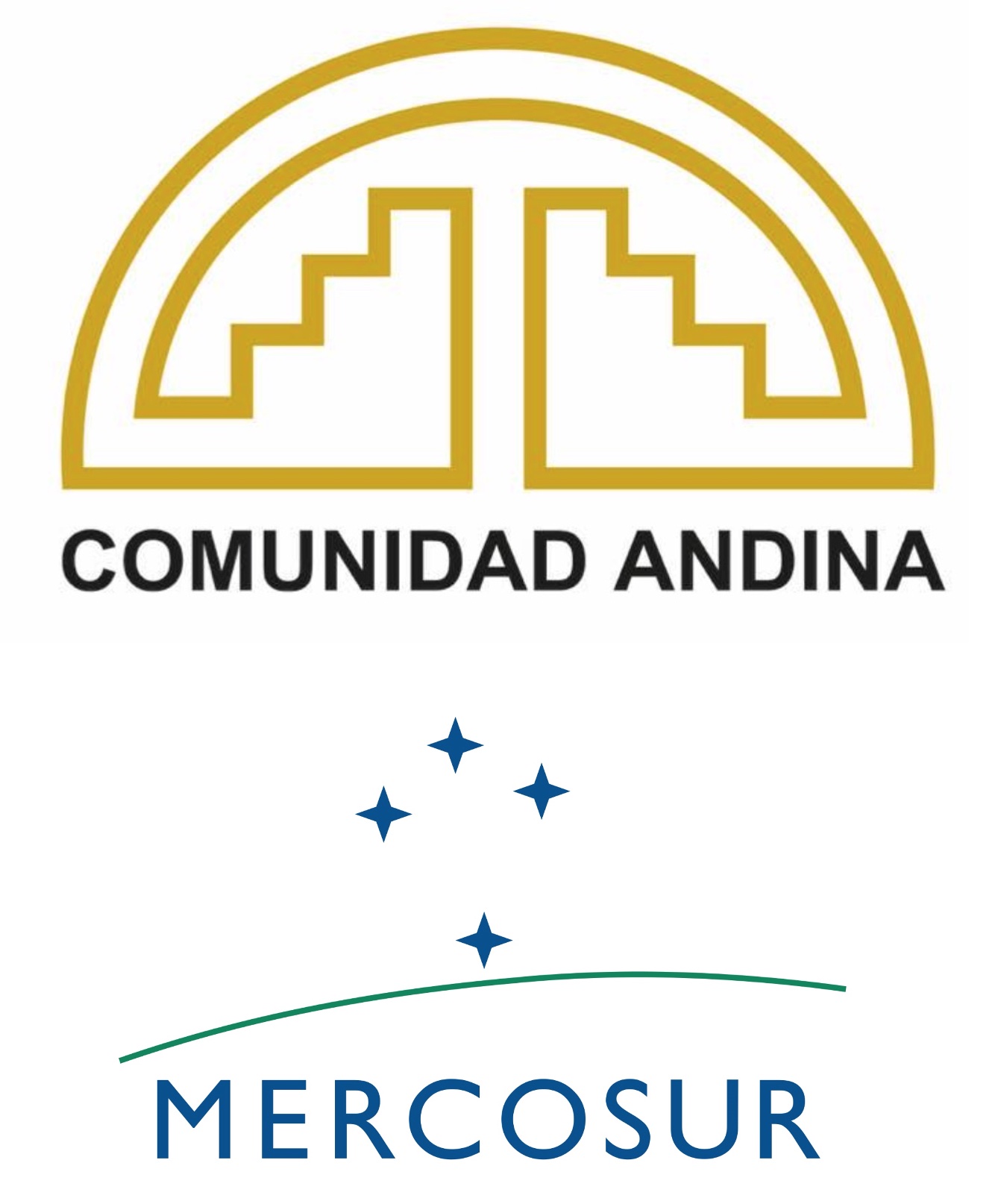
The table above also highlights the major trading blocs in South America.
- Comunidad Andina: The Andean Community, formerly known as Pacto Andino, is a free trade area with the objective of creating a customs union comprising northern South American countries.
- Mercosur: The Southern Common Market is a South American trade bloc. Its origins are linked to a regional economic market for Latin America.
It is essential to highlight that nonmember countries are associated countries, bringing the whole continent into an extensive trading agreement.
South America's Economy
The economy of South America is characterized by a mix of diverse sectors, natural resource abundance, and varying levels of development among its countries.
Natural Resources in South America
South America is rich in natural resources, which play a significant role in its economy.
Countries such as Brazil, Chile, Peru, and Venezuela have substantial mineral deposits, including copper, iron ore, gold, silver, and lithium.
The region also possesses significant oil and gas reserves, particularly in Venezuela and Brazil.
The Amazon Rainforest in Brazil and other countries also provide timber, biodiversity, and potential for ecotourism.
Agricultural Production in South America
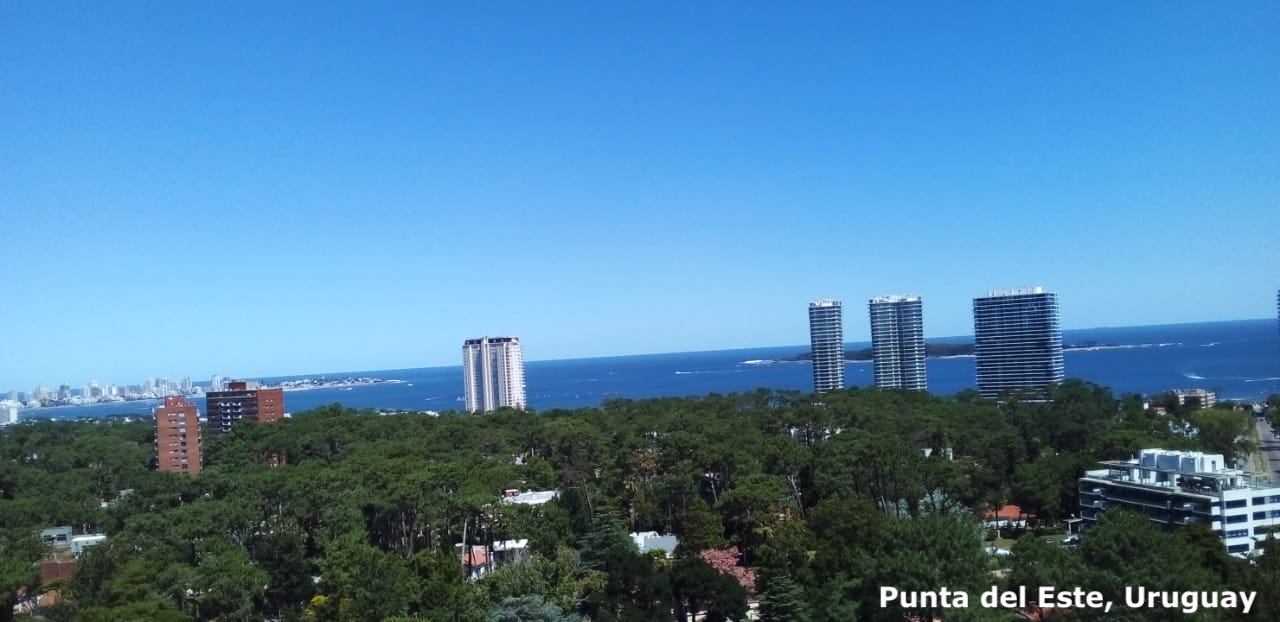
South America is a major global player in agricultural production. Countries like Brazil and Argentina are among the world's largest exporters of commodities such as soybeans, beef, poultry, corn, and wheat.
The fertile plains of the Pampas in Argentina and the Cerrado region in Brazil contribute to the agricultural strength of the continent.
Coffee production is another important sector, with Brazil being the largest coffee producer in the world. Colombia is the third largest coffee producer.
Manufacturing and Industry
Several South American countries have developed manufacturing industries.
Brazil has a diverse manufacturing sector, including automobile manufacturing, machinery, textiles, and chemicals.
Chile has a strong copper smelting and processing industry, while Colombia has a growing textile and apparel manufacturing sector.
Additionally, countries like Argentina and Uruguay have established automotive manufacturing industries.
Resources for South America Map
The shapefiles with the world's countries, rivers, lakes, and oceans were obtained from Natural Earth.
This map will be updated with new data! To receive updates on this and more maps, join my email list!!!!!!!
Made by Luz K. Molina with D3.js.
